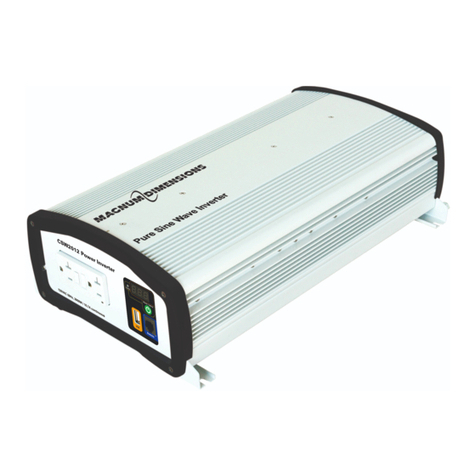
© 2015 Sensata Technologies iii
Table of Contents
1.0 Introduction............................................................................. 1
1.1 Features ................................................................................. 1
1.2 How this Inverter Works............................................................ 4
1.3 Advantages of a Pure Sine Wave Inverter .................................... 4
2.0 Installation .............................................................................. 5
2.1 Pre-Installation ........................................................................ 5
2.1.1 Installation Guidelines ........................................................ 5
2.1.2 Unpacking and Inspection ................................................... 5
2.1.3 Tools Required ................................................................... 5
2.2 Locating and Mounting the Inverter ............................................ 7
2.3 Wiring the Inverter – General Requirements ................................ 9
2.3.1 Wiring Requirements .......................................................... 9
2.3.2 Torque Requirements.......................................................... 9
2.4 DC Wiring ............................................................................. 10
2.4.1 DC Wire Sizing................................................................. 11
2.4.2 DC Overcurrent Protection................................................. 12
2.4.3 DC Grounding.................................................................. 12
2.4.4 DC Cable Connections....................................................... 12
2.4.5 Wiring the Battery Bank.................................................... 13
2.4.6 Appliances and Run Time .................................................. 13
2.4.7 Wiring the Inverter to the Battery Bank............................... 14
2.5 AC Wiring.............................................................................. 16
2.5.1 Pre-AC Wiring Requirements.............................................. 16
2.5.2 AC Wire Size and Overcurrent Protection............................. 16
2.5.3 AC Neutral to Safety Ground Bonding ................................. 17
2.5.4 AC Terminal Block Connections .......................................... 18
2.5.5 AC Conductor Wiring Steps................................................ 18
2.5.6 Removing the Display Panel............................................... 22
2.6 Testing the Inverter ................................................................ 23
2.6.1 Inverter Functional Test .................................................... 23
3.0 Operation............................................................................... 24
3.1 Inverter Mode........................................................................ 24
3.2 By-Pass Mode ........................................................................ 24
3.3 Display Panel Operation .......................................................... 25
3.4 Understanding Loads .............................................................. 28
4.0 Troubleshooting..................................................................... 29
5.0 Specifications......................................................................... 35
Appendix A - Battery Information ................................................ 36
Battery Bank Sizing ...................................................................... 36
Battery Types............................................................................... 36
Battery Configuration.................................................................... 36
Series Wiring ............................................................................ 36
Parallel Wiring........................................................................... 37
Series-Parallel Wiring ................................................................. 37
Appendix B - Preventive/Periodic Maintenance............................ 38
Recommended Inverter and Battery Care ........................................ 38
RV/Marine Off-Season Storage ....................................................... 38
Appendix C - Regulatory and FCC Information.............................. 39
Appendix D - Limited Warranty .................................................... 40
How to Receive Warranty Service.................................................... 40





























